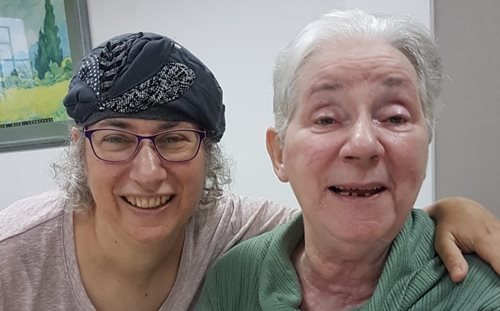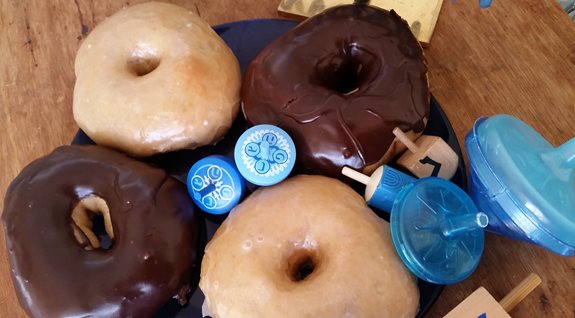
Double Your Impact for the Holidays
Double Your Impact for the Holidays
Your urgently needed year-end gift can go twice as far to provide care and support and accelerate Alzheimer's research this holiday season — and all year long. Show your giving spirit today during this 2x Match Challenge.
Donate NowA long-time contributor to the Alzheimer’s Association blog, Miriam Green shares her caregiving stories and the recipes she learned from her mother, Naomi, who is living with Alzheimer’s.
Chanukah has always been a symbol of finding light within the darkness.
While many Jewish holidays begin in the mid-moon cycle, Chanukah starts during the short days of winter when the moon is waning. It is the candles of this Festival of Lights — not the moon’s tiny glow — that illuminate our night sky.
 Historically, the celebration commemorates the rededication of the Second Temple in Jerusalem in 164 BCE by a small band of Maccabees who overpowered their Syrian-Greek oppressors.
Historically, the celebration commemorates the rededication of the Second Temple in Jerusalem in 164 BCE by a small band of Maccabees who overpowered their Syrian-Greek oppressors.
For me, the holiday has come to represent my efforts to shed light on my mom’s Alzheimer’s.
We’re in our 11th year of watching Mom decline, 11 years of agonizing incremental loss, and, surprisingly, moments of clarity and joy. Mom is physically healthy, though she no longer remembers her beloved family. She’s in her third year of living in memory care, and we are doing our best to visit during the pandemic.
What pearls of wisdom have I distilled during this time? I humbly offer five realizations about being the daughter of a mother with Alzheimer’s.
1. Anger. Denial. Fear. The emotional changes that your loved one goes through in the initial stages of Alzheimer’s don’t usually go away. They often get more intense and entrenched. The good news? With time, though it’s hard to expect the unexpected, you learn how to turn those emotions around to produce laughter and joy and strength in your love, even when misperceived as unrequited.
2. Music can ignite a light in someone living with Alzheimer’s — even when other memories are gone. It gives us a way to still reach our loved one. Use it whenever you can to give comfort and provide well-being. It is such a pleasure to watch our loved ones become animated by the songs of their past, even if momentarily.
3. Being with your loved one is much better when there is a reciprocal relationship. Even the smallest recognition of who you are and why you’re there is enough to buoy you. But that’s not why we keep visiting and interacting. We keep visiting because we know that buried deep behind that vacant stare is the person who is deserving of our affection and attention. And we’re here for the long haul, even when it’s a one-way bond.
4. There are many things to embrace throughout this journey. Embrace your loved one’s altered reality; embrace their ever-changing limitations in understanding simple things, like how to cut vegetables or do the laundry, dress or wash; embrace their emotional vulnerability; embrace, too, their changed physical needs as they lose the ability to walk or swallow.
5. This journey is also about you, the caregiver. It’s about stepping up to acceptance, finding ways to let off steam, relying on others to assist you, realizing that you’ve become your loved one’s memory repository, being able to tell their story as well as your own and moving forward (hopefully with minimum guilt) with your own life.
Don’t go through this journey alone. Sharing my pain and bewilderment with other people in the same situation helped. Soon after Mom’s diagnosis, a friend, Judy, whose mother also had Alzheimer’s, took me out for coffee and openly answered every question I asked her. I was affected most profoundly by her relating that her mom did not know who she was anymore. I could not then imagine how a daughter’s whole life could be swallowed up by this disease. Now, sadly, I know better.
It took a long while, but eventually I found ways that helped us minimize Mom’s confusion. Once I was able to listen patiently to Mom’s often incoherent statements, bring her into conversations instead of talking over her head, assuage her anger, find ways to make her laugh, learn to be in the moment, and love her unconditionally, the effect was like shining a bright light in a dark place and finding that the room was filled with hidden blessings.
Chanukah is an eight-day festival. Each successive day we light one more candle, until on the eighth day, there is a blaze of light spilling from our windows. “The proper response, as Chanukah teaches, is not to curse the darkness but to light a candle,” explains Rabbi Irving “Yitz” Greenberg.
That is exactly my intention.
_____________________________________________________________________
Chanukah, oh Chanukah. Doughnuts are the least interesting part of Chanukah historically, but they are synonymous with the modern-day holiday. ‘Tis the season to eat as many fried foods as possible, and doughnuts are at the top of the list. The trick is to eat them without gaining a million pounds. Here’s a sensible recipe that I made especially for my dad.
Saba No-Fry Doughnuts
No milk, no fried dough. Dad deserves a special treat. They came out well and they give the illusion of eating a real doughnut. The less you knead the dough, the spongier the doughnuts turn out.
 Ingredients
Ingredients
2 teaspoons yeast
½ cup sugar
¾ cup warm soy milk
4 eggs
½ cup oil
3¾ cups flour
1 teaspoon salt
1 teaspoon vanilla
Icing
1½ cups powdered sugar
2-3 tablespoons soy milk
1½ teaspoon vanilla
For chocolate icing, add 2½ tablespoons baking cocoa
Directions
Proof yeast in a small bowl by adding yeast, sugar and warm soy milk. Let react for 15 minutes. Add eggs and vanilla. Sift in flour and salt. Knead till dough forms. Let rise for two hours in a warm area. Refrigerate dough overnight (can be up to two days). Remove from fridge and shape as follows: Without kneading the dough, make fist-sized balls and place on a baking tray covered in baking paper. Use a small, round cookie cutter or other item to make the doughnut holes. When all the doughnuts are made, cover with a towel and let rise for up to an hour in a warm area. Brush tops with egg and bake at 375° for 15 minutes. Meanwhile, in a separate bowl, mix icing ingredients. Dip warm doughnuts in icing then let cool. Microwave for 15 seconds just before eating.
About: An award winning poet and author of The Lost Kitchen: Reflections and Recipes from an Alzheimer’s Caregiver (Black Opal Books, 2019), Miriam transitioned post-COVID into content writing for a tech startup. Prior to that, she worked for 18 years as a counselor helping new immigrants adjust to life in Israel. She holds an M.A. in Creative Writing from Bar Ilan University, and a B.A. from Oberlin College. Miriam is a 30-year resident of Israel, and a mother of three. You can find her on Facebook and Twitter.
